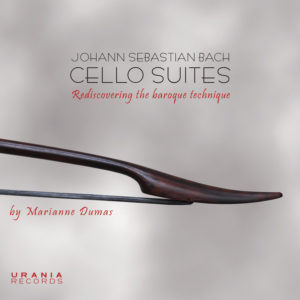
Marianne Dumas. Bach Cello Suites. Urania Records. LDV 14036. Released 2018. Recorded at the B- sharp studio, Berlin 12-14th January & 15-16th March 2016.
Instruments of the recording:
4 string baroque cello by Daniel J König, Leipzig
5 strings baroque cello by Johannes Loescher, Köln
Baroque bow by Hans Reiners, Berlin.
Baroque tuning employed although no mention of this in the notes.
The Recording.
The acoustic employed in this recording is somewhat dry. There is just a little echo. The recording manages to avoid too many extraneous noises such as breathing and mechanical taps from fingers. These seem to be a feature of many baroque recordings of the Suites due to close microphone techniques.
When I review a recording, I do try to avoid approaching the usually pleasurable task without too many preconceived ideas or views. This is because my brain like most other music lovers of a certain age has already experienced many hours of music of all sorts. I calculate for me that is well over a hundred hours of listening to Bach cello suites!
Our brain has an amazing ability to recognise shapes and patterns in music, which determines how we respond when we hear recordings. The result of this is that we can fill in gaps, correct, and literally fool ourselves as to what we are hearing. This way we end up hearing what we want to hear not what we actually hear.
Part of my strategy, is to avoid reading sleeve notes until after listening. Some notes are so sparse or poorly written that they have no chance to influence but others are incredibly informative and insightful. This recording in hand falls into the latter!
The music.
Without the benefit of reading the notes, it was evident this recording was was a historically informed recording using original instrumentation and gut strings. There was a clue I could not avoid on the album cover as well, with Baroque bow and sub title “rediscovering the baroque technique”!
However, this one was different in that there was a softer gentler sound. There is less evidence of the attack, rhythmicity and articulation of many baroque recordings. The harmonics of the notes were more clearly audible and there is an impression of a relaxed performer drawing out the notes without force or excessive effort. This applies particularly to the first three Suites, but some strain and a sense of scrabbling for notes is evident in the more complex technically demanding later Suites.
A curious finding.
Although there is good dynamic variation and moderate rubato, there was surprisingly a tendency for each movement to merge. The dance styles were not emphasised, and slow movements tended to be brisker than in some recordings whilst faster movements tended to be somewhat slower.
The results are far from bland but I would not say I experienced many moments of being gripped and excited!
Having read the notes there were three key matters which clearly influenced this recording. The first was that Dumas had decided to play the Suites with the bowing reversed. In general, this means playing key notes on an up bow as opposed to a stronger down bow. As any string player would confirm, this would be a little like swapping hands over, or riding a bicycle where the steering was altered to turn a wheel in the opposite direction to turn of the handlebars!
The second was a focus on posture and technique to improve resonance linking in with the reversal of bowing.
Thirdly was a determination to approach the whole matter of recording the Suites as a research project.
Science v. Emotion.
In the notes the performer is quoted as saying “When I was recording the Suites, I was far more interested in the sound than in my own emotions.” Also “I want to keep for myself the freedom of being able to perform the Suites in a much more personal way during live concerts.”
To my mind the insight above does explain the diminished articulation and rhythmicity. It also explains why the recording failed to grip in a more emotional sense. However, that is not to take away from Ms Dumas the magnitude of what she has set out to achieve. She has gone right back to basics, and re-thought her technique and style of playing. In doing so she has created a recording that is definitely different from all the others and with significant artistic merit. I have to say that given the performer has in effect made life very difficult for herself, the results are to be applauded.
Conclusion.
I for one will experiment with reversed bowing and in fact suspect it will help in my playing of baroque music particularly as I am aware of a tendency to have a weak “up bow”.
In addition, after Covid I shall seek to experience the live performance if possible, to complete the whole picture that I’m sure Ms Dumas is capable of laying out in front of the listener.
PS do not forget to view Marianne Dumas’s excellent web site, wherein you can read much more about her philosophy and approach to this recording and much more.
Charles.